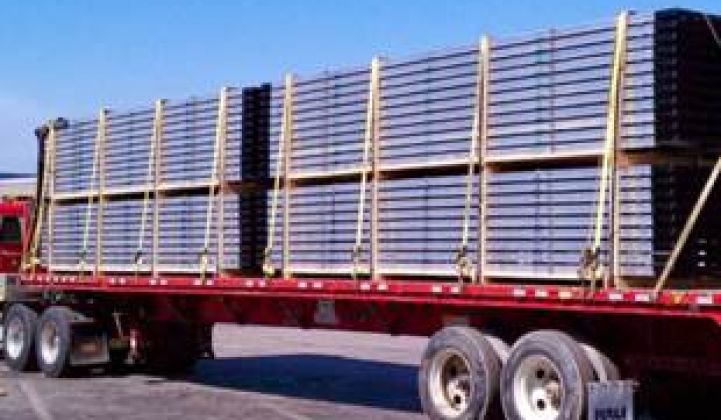Significant cost cuts in niche areas are still possible that could bring utility-scale solar down to $1.35 per watt, according to a panel of industry experts at the recent GTM Solar Summit.
Five to ten years out, inverter and tracker technologies will have significant impacts on balance-of-system costs, according to E3 International Engineering VP John Schroeder. But for now, perceived risk limits innovation. According to Schroeder, it's very important to avoid taking steps that could increase risk, "because in today’s market, the cost of capital greatly trumps BOS costs.”
Eventually, developers will come to regard a more expensive tracking system as a better buy than fixed-tilt racking. “A tracker is smart enough to get out of the wind, so we should have less steel,” he said. That will offset the higher cost. “And you should get 15 percent to 20 percent more energy.”
According to Larry Truong, Power-One's director of business development, the biggest cost reduction opportunity for inverters will be in optimizing the design of the skid structures that house an installation’s electronics.
Power-One is working to cut up to $0.05 per watt from installed system costs with new materials and cabling, as well as a design that reduces shipping costs. But, Truong added, the company wants to maintain the skid's protection of system components, as well as the minimized union field labor that factory pre-assembly allows.
Shoals Technologies has also been focusing on skids, according to founder and CEO Dean Solon. The firm has a solution that allows a single flatbed truck to deliver a skid with a transformer and two inverters. “Our customers have pushed us to build an open architecture, plug-and-play framework,” he said.
Another BOS cost solution that Shoals has developed is a prefabricated multiple-gauge wiring harness. “Our goal is to have the entire electrical solution installed by general labor instead of electricians.”
After looking at the complete utility-scale solar landscape, from manufacturing to assembly and from logistics to labor, Alion Energy decided costs can only come from new materials, part pre-assembly, and automation, said CEO Mark Kingsley. “If you don’t design costs out, you’re just waiting for inflation to put costs back in.”
Alion’s robotic installation and panel-cleaning solutions eliminate labor costs, he explained. “Standardization and automation can really take costs out.”
But according to E3's Schroeder, “I would love to see that work, but it doesn’t pencil out in the field."
“It has to be plug-and-play solutions,” Shoals' CEO Solon emphasized. “The module and BOS costs have been squeezed. The next big push is labor.”
BOS cost reductions for utility-scale developers could come by moving from the current 1,000-volt DC standard to a 1,500-volt standard, the panelists agreed. Shoals’ higher voltage wiring harnesses could bring prices down if they could get IEC and UL certification, Solon said. “They need to clean that mess up.”
Bigger 96-cell modules are unlikely to be a source of cost savings, as many installers have rejected them for being too heavy to lift, Kingsley said.
“If you go larger, beyond what a person can lift, you should go very large,” Schroeder said. Mechanically handled mega-modules change labor costs, “but the value proposition is still murky to me.”
Schroeder also doubted the benefit from innovative but higher-cost AC smart modules. In utility-scale solar, “cost is king," he said. "Smart modules work better for rooftops.”
The smart module, with its built-in electronics, is “an interesting concept” but traditional electronics manufacturer Power-One is waiting to see if the marketplace adopts it, Truong said. Storage technologies are the more likely innovation to add to utility-scale solar’s value proposition by “stabilizing the grid” and “taming the duck.”
“The whole supply chain has been squeezed in the last three years. Everybody is working in single-digit margins,” Solon said. Because going slower means more labor costs, “the only place where there is a difference is in how fast you install and commission the system.”
Watch the panel discussion:
See more videos from Solar Summit on Greentech Media's Ustream channel



